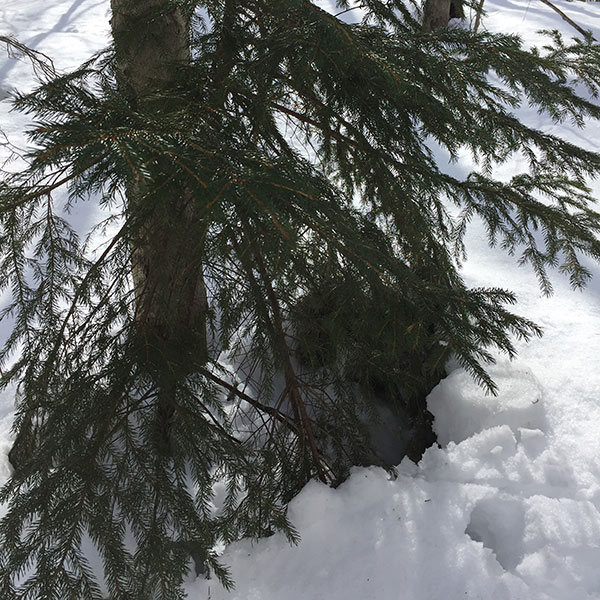As if there weren’t enough to worry about these days, now I’ve got a new phobia: A phenomenon specific to snowy, woodsy locales known as a tree well. Up here in Stowe, VT, we had an absolutely horrifying and tragic incident on the mountain 11 days ago in which a 22-year-old snowboarder fell headfirst into one while riding in woods between designated trails with a friend, at the end of a storm which had dumped almost 2 feet of snow on the mountain. He was found eight hours later after an extensive search, almost completely covered in snow, with only his snowboard and legs visible. He did not survive the ordeal.
If you’re wondering what a tree well is exactly, you are not alone. It is an area of deep, loose snow around the base of a tree that has the approximate circumference of the widest point of the tree. Tree wells develop in deep snow, and are less easily spotted and deeper around low evergreen trees that have the appearance of Christmas trees sitting on top of the snow, with branches close to the ground. The reason why the wells form under these trees is that during a heavy snowfall, the dense branches of the tree will catch much but not all of the snow; the snow piles up under the tree, but is not as heavy and packed down by the weight of continued snowfall as the snow several feet away from the tree would be. This situation creates a dangerous and sometimes deadly well of deep, loose snow which can trap unsuspecting skiers and snowboarders if they navigate too close to the tree. These wells also can develop near rocks and streams, and depths of up to 20 feet have been recorded.
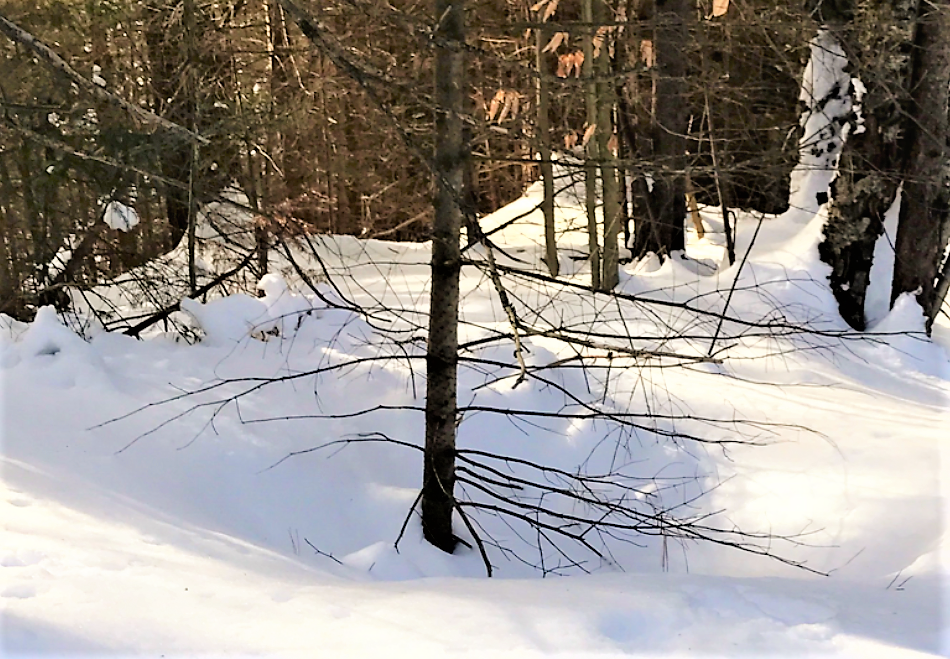
Photo of a tree well taken in a friend’s woods, 2/13/17
Tree wells are most commonly encountered during or immediately after a heavy snowfall, on the downhill side of a tree on a steep slope, and in ski areas where relatively warm, stable temperatures keep the snow soft. They are more common in the ski areas of the western U.S. than in the northeast, where our snow depths on average are significantly less, and where our warming/freezing cycles create a lot of ice. My research turned up more tree well incidents in places like Washington and Idaho than in Vermont. But clearly they do happen here. You only need to search “tree well” on the Internet to pull up news reports of tree well accidents, and terrifying videos of skier and snowboarder rescues. Another fatal incident occurred only yesterday in the Lake Tahoe ski area, to a 43-year-old male snowboarder from Connecticut, who was pulled from the well by two other skiers but did not survive the incident.
I heard about the Stowe incident in my clinic the day after it happened. As one who is relatively new to Vermont, I had not heard the term “tree well” before, but knew instantly as it was being described to me that I had lost a ski in one 4 winters ago in a rather unnerving experience. Mark and I somehow managed to be out skiing without the kids on an amazing powder day and were skiing out of bounds like idiot flatlanders in the Kitchen Wall woods, blissfully unaware of any peril and probably way too fast. I had a close call with a big evergreen tree, put my arm out for protection and basically rebounded backwards off its low branches and double ejected from my skis. I scooped up one ski but couldn’t find the other one. After 10 minutes of looking around I was resigned to hiking out in the deep powder when I saw the tip of the ski sticking straight up under the tree. It was disorienting: How did my ski get stuck down in the ground? It took me approximately 40 minutes to dig and pull it out, and I recall looking down and thinking that the ski got stuck in the tree roots, which I realize now were actually the lower branches of the tree. It was confusing and unnerving and I was glad to be out of there and have not gone back since. In retrospect, I was pretty lucky, especially since Mark was probably at least 50 feet in front of me.
Other Vermonter friends of ours have had some close calls. A close friend fell into one when he was 12 and was fortunately rescued by two girls skiing in the woods. A friend of my daughter’s fell into one a few years ago and fortunately was instantly pulled out by her ski group.
Although tree wells are bad news for everyone, snowboarders seem to be particularly at risk for entrapment in a tree well because it is more difficult to extricate their feet from the bindings, and the wide, flat board exerts pressure on the snow and does not sink as rapidly as the person attached, so frequently the snowboarders end up in a head down position suspended by the board above the snow and unable to free themselves. Skiers also wind up in the head down position but have a little more maneuvering ability because their legs have more freedom to move.
The official cause of death from tree well accidents is known as “snow immersion,” which can refer either to hypothermia or suffocation in the powder. Therefore, survival techniques for clearing the airway and getting as close to the surface as possible for timely rescue are essential. My research also turned up a possible risk of concussion from contact with a tree trunk as a contributing factor to snow immersion. Most skiers and riders, however, sensibly wear helmets these days which decrease although do not prevent concussion risk; therefore, chances are good that most tree well victims would be conscious after their fall, which greatly improves their chances for survival if they have been trained in survival techniques.
I was so upset when I heard about the incident on the mountain that I couldn’t sleep for several nights. My kids, like most Vermont kids, have grown up skiing and are unafraid. They rip it up in the woods and on the steep slopes, feel safe and comfortable and think they’re immortal. Compared to tree wells, my previous concerns related to tree skiing—namely the kids getting lost or hitting a tree—seemed like a walk in the park! And as the news gradually broke over the course of the week, many other parents voiced the same fears. How do we keep the kids safe? Do we ban skiing the trees? Equip them with a backcountry pack that includes an avalanche airbag, beacon and shovel? And this particular issue raises parenting dilemmas at large. An activity that we naively believed to be relatively safe is revealed to have some significant risk. Do we ban the activity altogether and take away a healthy outdoor activity that the kids love? Do we raise kids’ anxiety level, which studies show is higher today than ever, by weighing them down with equipment and dire warnings which, if we play the statistics, are fairly likely they will never need? Or do we educate them on prevention, teach them what to do in an emergency situation, and trust them?
I’ve been a complete basket case about this. Want to feel better about yourself? I was such a panicked wreck the first week after the Stowe incident that I actually followed two random kids, through completely packed down green circle woods that are not challenging for most 4-year-olds around here, while waiting to pick up my kids after their Friday program. Yeah that’s right, I followed them, literally shaking and in a cold sweat, ready to save them if they encountered a tree well. Yeah, I’m nuts. You’re doing just fine. Fortunately for my mental health, the Stowe schools were on top of things, putting the kibosh on any and all tree skiing for all kids at any age and skill level in Friday program that week.
So I chose to involve my kids in this blog. The first thing I learned, which I will relearn over and over, is that kids do not necessarily view the world the way that adults do. While I was having anxiety attacks over snowy deathtraps on the mountain, it seems that the kids in town thought the incident was fabulously exciting! Suddenly all of 9-year-old Matthew’s friends were telling stories of their dramatic escapes from tree wells on the mountain, in which they pulled themselves up and out singlehandedly using branches, and in the stories no parents ever seemed to be anywhere nearby! My kids didn’t have a great attention span for my long-winded scientific explanations of what tree wells were and how they formed, but they were very interested in the specifics of how to find one, what would happen if they fell into one, and how to get out.
So naturally, being us, we set out on an expedition last weekend into the woods on our property for some field research. Our mission was to search for tree wells and our loose plan was to throw each other into them and see how to get out. We went out equipped with shovels and a tow strap, and being a conscientious mother I was supposed to let one of the kids fall into a tree well and then provide the rescue, and if I couldn’t get us out then the two other kids would go get Dad. In my defense of this asinine plan, the snow is not hazardously deep in our woods, and we’d studied various techniques on the Internet for extricating ourselves. So we figured it should all work out.
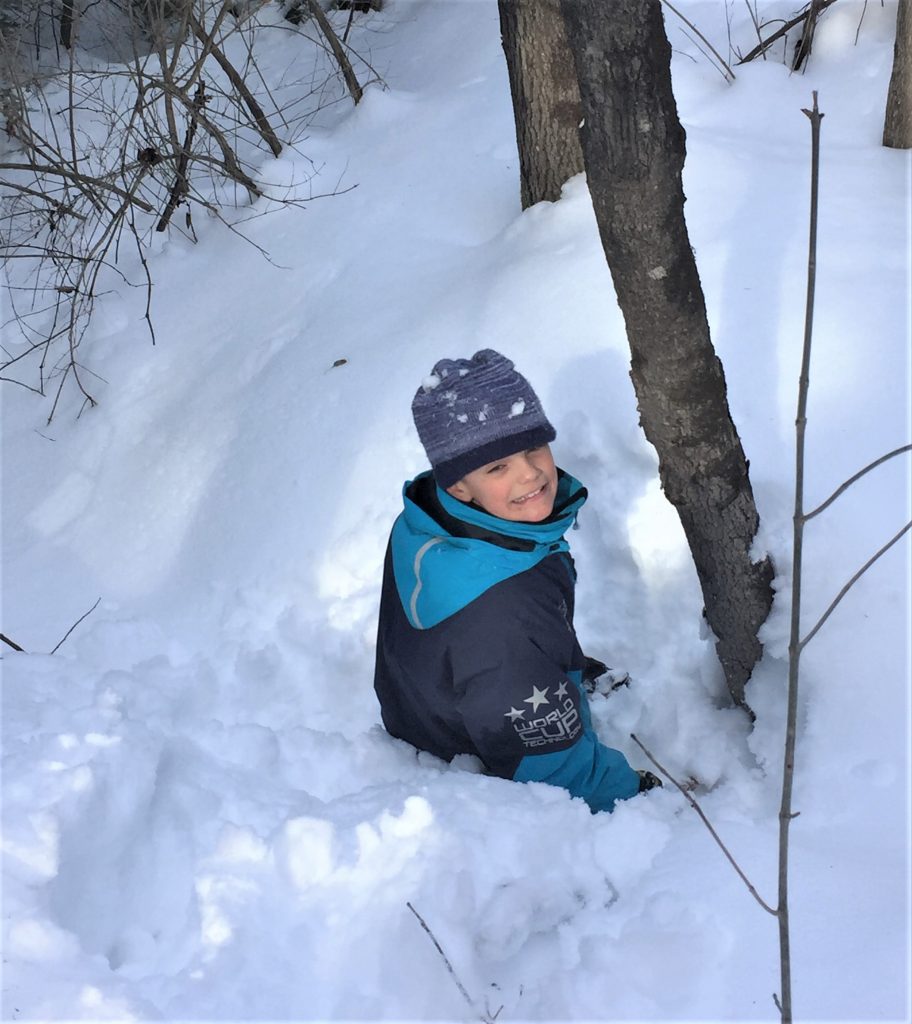
We found one! Matthew, waist deep in a shallow tree well in our woods.
Before we even get into escape tactics, let me say that that prevention of a tree well accident is really the safest way to go. Tree wells are no joke, and the statistics on tree well accidents show that only 10 percent of those who fall into a tree well are able to get themselves out. I know neither how this data was collected nor how accurate it is. I have a feeling that these incidents are underreported. But the incident in Stowe reminded us how important it is to ALWAYS tree ski in groups of at least three people, and to have a protocol: Everyone stay together, and do not lose sight of each other. Carry a phone. If you are separated, make your way out of the woods as quickly as possible and wait for your group. If you have a phone, call a member of your group. If someone in the group does not turn up in a couple of minutes or answer their phone, call ski patrol immediately, and go back up with the other members of your group and retrace your steps, if you are an adult. It probably is a good idea as well to wait a day or two after a big snowstorm to ski the woods, in order to let the snow settle, and ski or ride in packed down tracks if you can.
But groups get separated and phones do not always work, so it’s good to have an emergency backup plan if you get stuck. The kids and I did find one good, non-life-threatening stream dip and a shallow tree well, as well as a few deep piles of snow for practice, and here are the escape techniques that we tested out and found to be the most effective:
- Deep, loose snow is like quicksand. If you fall in, think of it as being stuck in quicksand or on broken ice. Don’t move for a moment. Do not panic, kick, or flail or grab for the top of the snow. You will only dig yourself in deeper. Stay calm. Slow down. Get your bearings. Keep yourself as flat and horizontal as possible, go against your instinct and press your body down evenly into the snow.
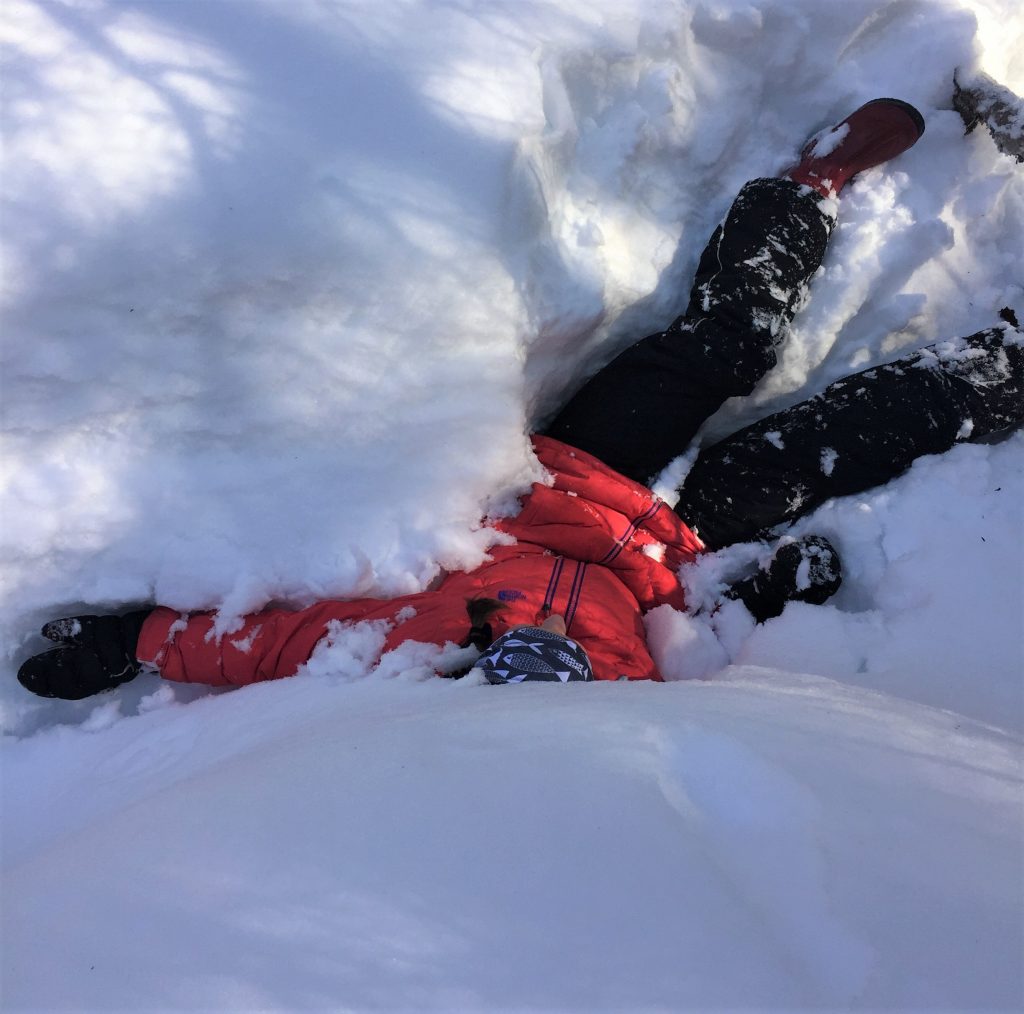
Natalie demonstrates how to stay still, flat, and horizontal and press your body into the snow.
- Gently cough. Clear your airway. Snow, I’m told, can form a cork in your throat. Get it out. Slowly, slowly, move your hands up to your face and see if you can clear a pocket of air around your face. Breathe.
- If you can reach your phone, call for help.
- Not sure which direction you’re facing? Head up or head down, face up or face down? Spit. Gravity will take your spit downward, so you will know that the surface is in the opposite direction of where your spit goes.
- Now try to establish if there is a tree trunk or branches close by.
- Next—try to pack the snow down around you by pressing your body into it to heat it up. The goal is to create a firm wall of support around you.
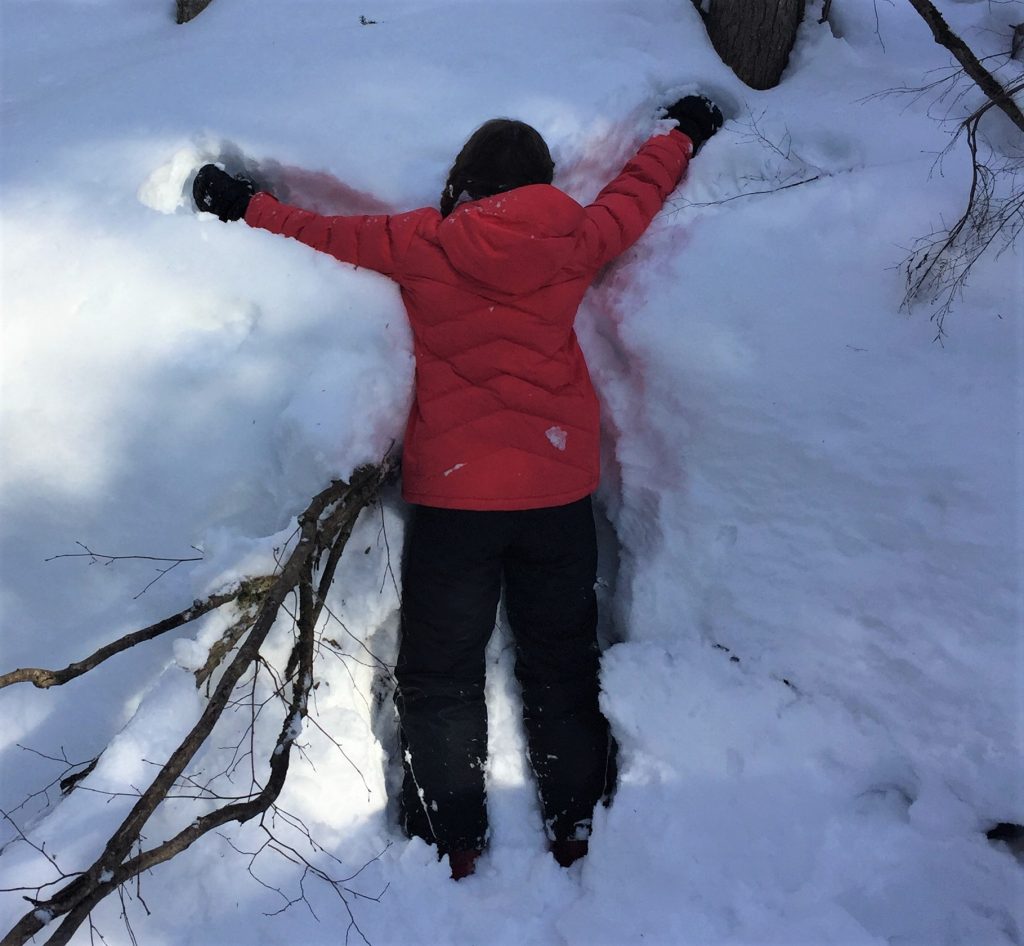
Nat shows us how to pack in snow in a stream dip to create a firm wall of support.
The jury is undecided on whether or not freeing yourself from your bindings is the best course of action. Your decision may be situational: If the well is small and tight, and a tree trunk or branches are close and you are able to grab them, you may do better to free yourself from your skis or snowboard if you can. If you are in a deep well or stream dip with nothing to grab onto, it might be safer to try to slowly maneuver with them on to prevent from sinking in deeper.
- Very, very slowly, try to maneuver yourself into a head up position. Use the tree trunk if you can. This may take a long time, even an hour or two. Don’t get discouraged. Stop and rest when you need to.
- Then if you can, wrap yourself around the tree trunk and try to pull yourself up. Again, move slowly, stop and rest, and don’t get discouraged. Reach for the branches. Yell for help. Continue to pull yourself up as high as you can and hold onto the tree.
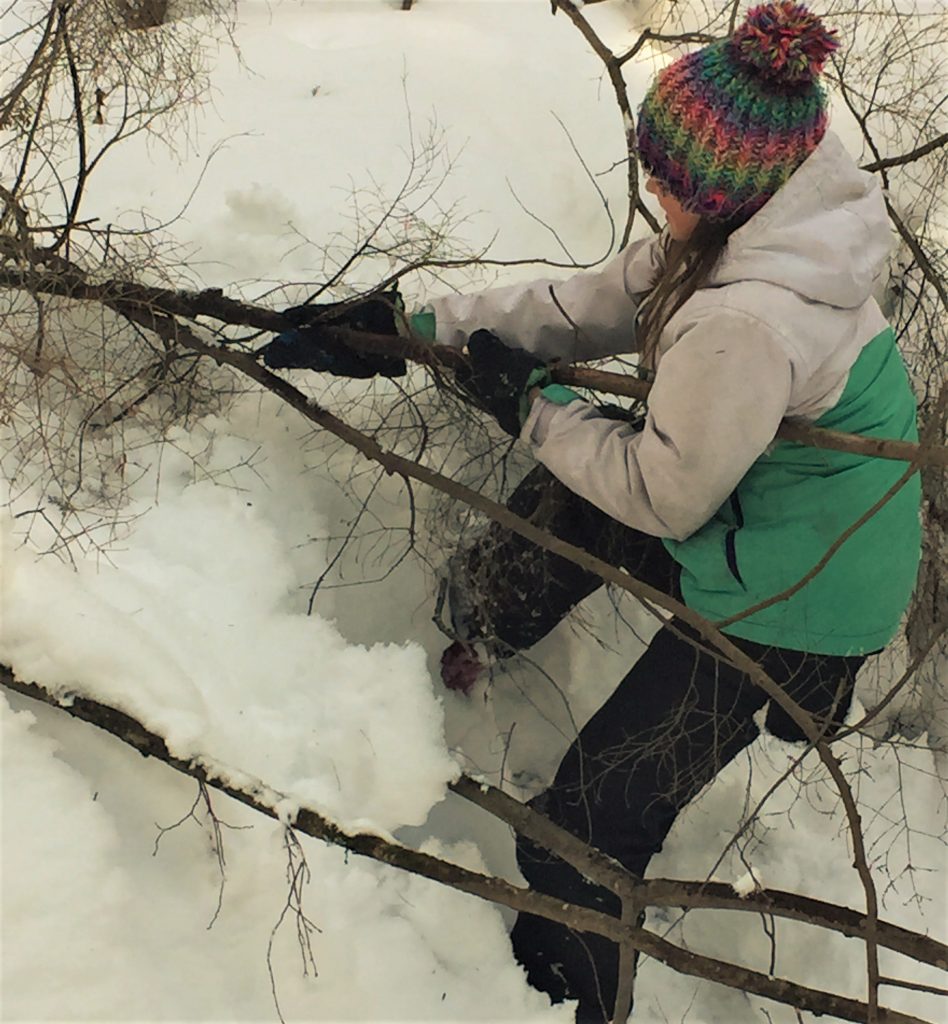
Gabs hauls herself upward using tree roots and branches after packing in the side of the stream dip.
- If you can’t pull up on the trunk or branches, keep pressing the snow flat around you and start to dig sideways, not up, as this will knock more snow down on top of you. The goal is to dig sideways to the edge of the well outside the branches of the tree where the snow is firmer and you have a better chance of getting out. Yell for help.
No matter what happens, stay calm, be brave, and believe you can do this. Decide that you will be one of the 10 percent. It’s amazing what situations humans have survived throughout the ages. You can do it.
A little practice in the snow in a safe place such as your yard, to see what it feels like to not panic if you are upside down with snow in your face, isn’t a bad idea. I tried it out myself ahead of time so I could tell the kids what to expect. Situations are frequently not quite as scary if you’ve encountered them before, even if they are simulated. This is the entire point of fire drills at school, for example. These techniques are not just applicable to tree wells. In any situation where you feel like you are stuck in the snow or lose your bearings in the woods, staying calm, moving slowly, and thinking things through should prevail.
Here in Vermont, we love snow, and the snowier, the better! Things can and do occasionally go wrong quickly in the cold, however, and just as we may have an emergency fire plan at home, it is good to have an emergency plan on the mountain. There are ways to make it fun without causing anxiety in children. A little not-too-scary practice, and patience in answering their 1,001 questions about all possible angles and aspects of the situation, will make them confident in their potential to handle an emergency. One hundred and ten percent guaranteed the experience will provide you with a new perspective that you’ve never considered—like what to do if you fell into a tree well, and there already were ninjas or zombies stuck down there with you.
–Kathleen Doehla, M.S. P.T.

